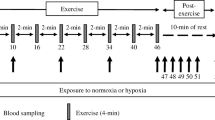Summary
Six thoroughbred horses exercised on a motorised treadmill on two separate occasions at a speed of 11 or 12 m· s−1 for up to 2 min. 4 h prior to exercise each horse was given a 21 test solution of sodium bicarbonate (NaHC03; 0.6 g·kg−1 body mass) or a control solution of water by nasogastric intubation, the order of administration of the two solutions was randomised. Blood samples (n=15) were obtained before and during the 4 h after intubation, during exercise and for 30 min after exercise. (NaHC03; ingestion resulted in changes in pre-exercise acid-base status. The changes in blood lactate and base excess with exercise were greater after (NaHC03; administration; after 1 min of exercise in the case of lactate (P<0.05) and immediately after exercise in the case of base excess (P<0.05). Plasma ammonia levels were lower during (P<0.05) and immediately after (P<0.05) exercise following (NaHC03; ingestion. The peak change in plasma ammonia with exercise was also lower after (NaHC03; ingestion (P<0.05). Following exercise after (NaHC03; ingestion, five horses demonstrated lower muscle adenosine 5-triphosphate loss (P<0.05) and inosine 5-monophosphate formation (P=0.05) and higher glycerol 3-phosphate formation (P<0.05). There is evidence to suggest that metabolic alkalosis may delay the onset of fatigue by decreasing the extent of adenine nucleotide loss during high-intensity exercise.
Similar content being viewed by others
References
Boobis LH, Williams C, Wooton SA (1982) Human muscle metabolism during brief maximal exercise. J Physiol (Lond) 338:21–22p
Chase PB, Kushmerick MJ (1988) Effects of pH on contraction of rabbit fast and slow skeletal muscle fibres. Biophys J 53:935–946
Costill DL, Verstappen F, Kuipers H, Jansson E, Fink W (1984) Acid-base balance during repeated bouts of exercise: Influence of HCO3 −. Int J Sports Med 5:228–231
Donaldson SKB, Hermasen L, Bolles L (1978) Differential, direct effects of H+ on Ca2+ activated force of skinned fibres from soleous, cardiac and adductor magnus of rabbits. Pflügers Arch 376:55–65
Dudley GA, Terjung RL (1985) Influence of acidosis on AMP deaminase activity in contracting fast-twitch muscle. Am J Physiol 248:C43-C50
Dunnett M, Harris RC, Orme CE (1991) Reverse phase ion-pairing liquid chromatography determination of phosphocreatine, creatine and creatine in equine muscle. Scand J Clin Lab Invest 51:137–141
Folley LS, Power SD, Poyton RO (1983) Separation of nucleotides by ion-pair, reversed-phase high performance liquid chromatography. J Chromatogr 28:199–207
Goldfinch J, McNaughton L, Davies P (1988) Induced metabolic alkalosis and its effect on 400-m racing time. Eur J Appl Physiol 57:45–48
Greenhaff PL, Snow DH, Harris RC, Roberts C (1990) Bicarbonate loading in the thoroughbred horse: dose, method of administration and acid-base changes. Equine Vet J, Suppl9:83–85
Harris RC (1981) Muscle energy metabolism in man in response to isometric contraction: a biopsy study. M Sc thesis, Aberystwyth, University College of Wales
Harris RC, Hultman E, Nordesjo LO (1974) Glycogen, glycolytic intermediates and high-energy phosphates determined in biopsy samples of musculus quadriceps femoris of man at rest. Methods and variance of values. J Clin Lab Invest 33:109–120
Harris RC, Marlin DJ, Snow DH (1987) Metabolic response to maximal exercise of 800 and 2000 m in the thoroughbred horse. J Appl Physiol 63:12–19
Hirche HJ, Hombach V, Langohr HD, Wacker U, Busse J (1975) Lactic acid permeation rate in working gastronemii of dogs during metabolic alkalosis and acidosis. Pflügers Arch 356:209–222
Horswill CA, Costill DL, Fink WJ, Flynn MG, Kirwan JP, Mitchell JB, Houmard JA (1988) Influence of sodium bicarbonate on sprint performance: relationship to dosage. Med Sci Sports Exerc 20:566–569
Hultman E, Bergstrom J, MClennan-Anderson N (1967) Breakdown and resynthesis of phosphorylecreatine and adenosine triphosphate in connection with muscular work. Scand J Clin Lab Invest 19:56–66
Hultman E, Spriet L, Soderlund K (1967) Energy metabolism and fatigue in working muscle. In: Macleod D, Maughan R, Nimmo M, Reilly T, Williams C (eds) Exercise: benefits, limits and adaptions. Spon, London, pp 63–84
Jones NL, Sutton JR, Taylor R, Toews CJ (1977) Effects of pH on cardiorespiratory and metabolic responses to exercise. J Appl Physiol 43:959–964
Kelso TB, Hodgeson DR, Witt EH, Bayly M, Grant BD, Gollnick PD (1987) Bicarbonate administration and muscle metabolism during high intensity exercise. In: Gillespie JR, Robinson NE (eds) Equine exercise physiology, vol. 2. ICEEP Publications, Davis, USA, pp 438–447
Kindermann W, Keul J, Huber G (1977) Physical exercise after induced alkalosis (bicarbonate or tris-buffer). Eur J Appl Physiol 376:197–204
Kowalchuk JM, Heigenhauser GJF, Jones NL (1984) Effects of pH on metabolic and cardiorespiratory responses during progressive exercise. J Appl Physiol 57:1558–1563
Lawrence L, Kline K, Miller P, Smith J, Siegel A (1987) Effects of sodium bicarbonate on racing standardbreds. In: Proceedings of the Tenth Equine Nutrition and Physiology Symposium, Colorado State University, USA, pp 499–504
Mainwood GW, Worsley-Brown P (1975) The effects of extracellular pH and buffer concentration on the efflux on lactate from sartorius muscle. J Physiol (Lond) 250:1–22
Marlin DJ, Harris RC (1991) Titrimetric determination of muscle buffering capacity in biopsy samples. Equine Vet J 23:193–197
Nakamura Y, Schwartz A (1970) Possible control of intracellular calcium metabolism by H+: sarcoplasmic reticulum of skeletal and cardiac muscle. Biochem Biophys Res Commun 41:830–836
Sahlin K (1978) Intracellular pH and energy metabolism in skeletal muscle of man, with special reference to exercise. Acta Physiol Scand Suppl 455:1–56
Sahlin K, Katz A (1988) Purine nucleotide metabolism. In: Poortmans JR (ed) Principles of exercise biochemistry. Karger, Basel, pp 120–139
Snow DH, Harris RC, Gash SP (1985) Metabolic response of equine muscle to intermittent maximal exercise. J Appl Physiol 58:1689–1697
Strome DR, Clancy RL, Gonzales NC (1977) Contribution of a net transmembrane HCO3 − to intracellular acid-base regulation. J Appl Physiol 43:931–935
Wikes D, Gledhill N, Smyth R (1983) Effects of acute induced metabolic alkalosis on 800 m racing time. Med Sci Sports Exerc 15:277–280
Author information
Authors and Affiliations
Rights and permissions
About this article
Cite this article
Greenhaff, P.L., Harris, R.C., Snow, D.H. et al. The influence of metabolic alkalosis upon exercise metabolism in the thoroughbred horse. Eur J Appl Physiol 63, 129–134 (1991). https://doi.org/10.1007/BF00235182
Accepted:
Issue Date:
DOI: https://doi.org/10.1007/BF00235182




